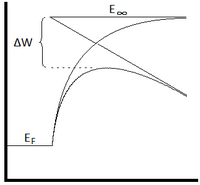Schottky effect

When you turn on a light bulb, electricity flows through a wire and makes the bulb light up. This kind of electricity flow is called "current."
Now imagine having a wire that is only made of one type of metal, like aluminum. When you try to make current flow through this wire, some of the electricity gets stuck on the surface of the metal. This makes it harder for the electricity to flow through the wire.
The "Schottky effect" is when a special combination of two different types of metals, like aluminum and gold, make current flow easier. When the two metals touch each other, a special type of connection is formed called a "Schottky barrier." This barrier helps the electricity move from one metal to the other without getting stuck on the surface, making it easier for the current to flow through the wire.
Think of it like a secret passageway between two rooms. The Schottky barrier opens up a new path for the electricity to flow from one metal to the other, like a hidden door between two rooms that you can only see if you know where to look. This makes it easier for the electricity to get to where it needs to go, just like a secret passageway would make it easier to get from one room to another.
Now imagine having a wire that is only made of one type of metal, like aluminum. When you try to make current flow through this wire, some of the electricity gets stuck on the surface of the metal. This makes it harder for the electricity to flow through the wire.
The "Schottky effect" is when a special combination of two different types of metals, like aluminum and gold, make current flow easier. When the two metals touch each other, a special type of connection is formed called a "Schottky barrier." This barrier helps the electricity move from one metal to the other without getting stuck on the surface, making it easier for the current to flow through the wire.
Think of it like a secret passageway between two rooms. The Schottky barrier opens up a new path for the electricity to flow from one metal to the other, like a hidden door between two rooms that you can only see if you know where to look. This makes it easier for the electricity to get to where it needs to go, just like a secret passageway would make it easier to get from one room to another.
